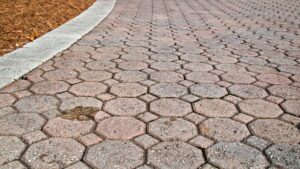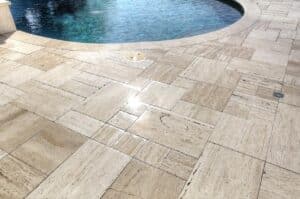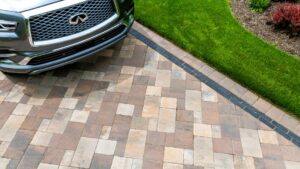Pressure washing pavers is a highly effective method for reviving the beauty of your outdoor spaces. Whether you have a patio, driveway, or walkway made of concrete, brick, or stone pavers, over time, they can accumulate dirt, grime, algae, and other stains. So what about some tips for pressure washing pavers?
In this article, our goal is to walk you through the steps to pressure wash your pavers safely and effectively. So let’s get right to it!
For a broader, full guide on paver maintenance, click here instead.
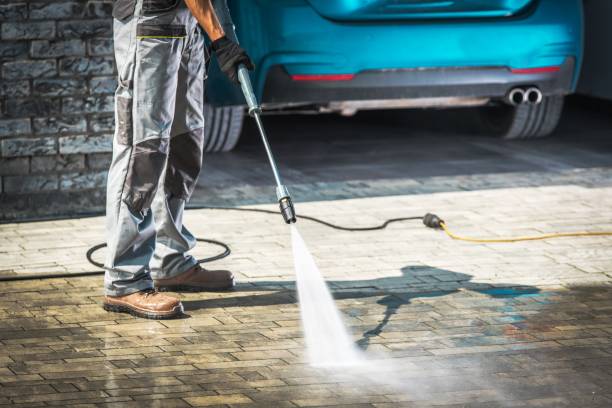
Tips for pressure washing pavers: right tools and materials
Let’s start by presenting you with a complete list of tools and materials you’re going to need for the job.
- Pressure washer
Of course, the pressure washer is the most important tool for the job – and investing in a high-quality one is crucial.
Pressure washers come in both gas-powered and electric models. Gas-powered ones are generally more powerful and are suitable for larger and tougher jobs, such as commercial spaces or heavily soiled surfaces.
Electric pressure washers, on the other hand, are perfect for most residential paver cleaning tasks. They are more lightweight, emit no exhaust fumes, and are easier to maintain. - Paver Cleaner
Selecting the right cleaning solution is key. Opt for a specialized paver cleaning solution that is compatible with the material of your pavers, whether they are made of concrete, brick, stone, or something else.
Ensure that the cleaner is safe for nearby plants and the environment, as some harsh chemicals can harm both your landscape and the ecosystem. - Safety Gear
Prioritize your safety while working with a pressure washer. Safety goggles will protect your eyes from debris and water splashes, ear protection is essential to shield your ears from the loud noise of the pressure washer, and sturdy gloves will safeguard your hands from potential abrasions.
Additionally, wear appropriate clothing that covers your body to minimize the chances of getting wet or injured during the cleaning process. - Nozzle Tips
Pressure washers typically come with various nozzle tips, each designed for specific tasks. For paver cleaning, opt for a 25-degree tip. This nozzle strikes a balance between power and gentleness, making it ideal for most paver materials.
It’s less likely to damage the surface while still providing sufficient force to remove dirt and grime. However, always be cautious and test a small, inconspicuous area first to ensure that the pressure is suitable for your specific pavers.

Before you start
Before starting your pressure washing task, it’s essential to create a clean and safe work environment.
Start by removing any furniture, equipment, or obstacles from the area you intend to clean. This includes chairs, tables, gardening tools, and any other items that could obstruct your access to the surfaces you want to clean.
Storing these items in a safe location prevents any potential damage, and it also ensures your safety as you won’t trip over them during the cleaning process.
Pressure washing can be powerful, and the high-pressure water stream, as well as cleaning solutions, can potentially harm delicate surfaces and plants nearby. To prevent this, take extra care to protect them – you may cover any sensitive or valuable surfaces, such as wood decks, glass windows, or fragile ornaments, with plastic sheeting or drop cloths. This will act as a protective barrier against the force of the water and any cleaning solutions you may use.
Likewise, if you have plants, flowers, or shrubs adjacent to your cleaning area, cover them with plastic or fabric drop cloths. These covers will shield them from any overspray and chemicals that might damage or discolor their leaves and flowers. Remember that some plants are more susceptible to damage than others, so tailor your protection measures accordingly.
One of the most important steps in preparing for pressure washing is to thoroughly clean the surface of loose dirt, leaves, and debris. Using a stiff-bristle broom or a leaf blower, sweep the area to remove any surface-level grime.
This initial sweeping not only ensures a more effective cleaning process but also prevents debris from clogging the pressure washer’s nozzle, which can reduce its performance and potentially damage the equipment.
For areas with stubborn dirt or heavy debris buildup, you might need to consider manual removal or specialized cleaning solutions. These can help loosen and dislodge deep-seated stains or substances like oil, grease, or mildew.
Setting up your pressure washer
Before you begin the pressure washing process, it’s crucial to properly set up your equipment.
Start by attaching the 25-degree nozzle tip to your pressure washer. This nozzle provides a balanced spray pattern that is suitable for a wide range of cleaning tasks.
Make sure that you are wearing the appropriate safety gear. Prioritize your safety by donning protective goggles to shield your eyes from any debris or splashback, and use ear protection to safeguard your hearing from the loud noise generated by the pressure washer.
Hold the pressure washer wand at a 45-degree angle to the surface of the pavers, and maintain a distance of approximately 12 to 18 inches between the nozzle and the pavers. This distance is crucial as it allows for effective cleaning without subjecting the pavers to excessive pressure.
Don’t miss: Brick paver walkway – a timeless trend
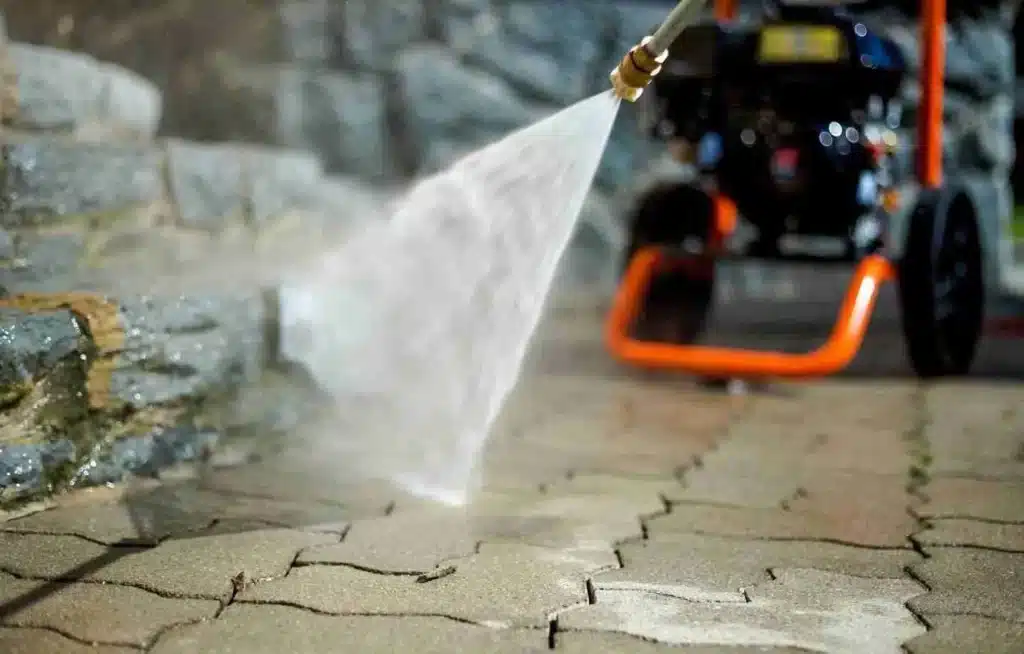
Pressure washing process
Adopt a systematic approach by starting at one end of the area you intend to clean and working your way methodically to the other end. Maintain a consistent pattern as you move the wand, ensuring that each pass slightly overlaps the previous one.
Avoid leaving it stationary in one spot for an extended period, as this can lead to etching or damage, particularly on older or softer paver materials. By maintaining a steady back-and-forth or side-to-side motion, you’ll achieve an even and effective clean without compromising the integrity of the pavers.
Gradually increase the pressure while observing the cleaning progress. The goal is to find the perfect balance between effective cleaning and paver safety. Be vigilant about not using excessive pressure, as this can lead to unintended damage, especially on older or more delicate paver surfaces.
By making incremental adjustments and carefully monitoring the results, you can ensure a thorough yet gentle cleaning process that preserves the integrity of your pavers. Remember that patience and precision are key when it comes to pressure washing, and erring on the side of caution is often the wisest approach to maintaining the quality and appearance of your outdoor surfaces.
Professional cleaning services
By following these tips for pressure washing pavers, you are sure to do excellent work without any major problems.
However, the best course of action to make sure you end up with the best possible results is to hire professional hardscape contractors to help you with the cleaning process. Professionals can assess your scenario and make the best decisions, as well as use the best products and techniques available.
That’s why we always recommend finding a professional you can trust around your area. And if you happen to be in our area of activity, the Sarasota and Manatee counties, in FL, you can always contact us for a free estimate on our services.

